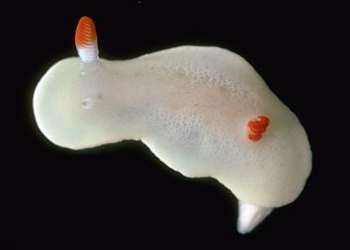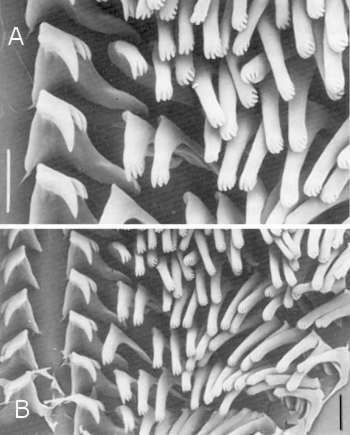

Noumea verconiforma
Rudman, 1995
Order: NUDIBRANCHIA
Suborder: DORIDINA
Superfamily: EUDORIDOIDEA
Family: Chromodorididae
DISTRIBUTION
New Caledonia, eastern Australia [sthn Queensland]
PHOTO
Upper: NW side of Récif de l'Infernet, 20 35.8'S, 164 12.7'E, 9-10m, in Lagoon, off Koumac, New Caledonia, HOLOTYPE, 6mm long alive, 15 October 1993, AM C200499 (in MNHN, Paris). Photo: Bill Rudman. Lower: Scanning electron micrographs of radula. A, Teeth 1-9 on right side. B, Section of radula showing central region and right side. Scale bar = 20 µm in all cases. Photo: A.C. Miller.
The mantle is translucent white with a reticulate pattern of opaque white, which gives a sponge-like appearance to the mantle, similar to that of Verconia. Around the edge is a thin band of opaque white. The mantle glands are not visible in the living animal. The rhinophore stalk is translucent clear, while the lower third of the rhinophore club is opaque white and the upper two-thirds bright orange-red. The gills are translucent white with a bright orange-red edge to the upper two-thirds of each gill. The gill lamellae in upper third of each gill (upper 3-4 lamellae) are also line with orange-red.
The underside of mantle, body and foot are all translucent white.
The mantle is ovate with a relatively broad mantle overlap. Approximately midway down each side the mantle edge folds out. This lateral 'widening' of the mantle is semi-permanent and gives this species, and others which also exhibit this feature, a cross-like appearance. The mantle glands are large, single opaque spheres, easily visible in the preserved specimen. They form an irregular band (of approx 15 glands) around the mantle skirt. There are seven simple gills which vibrate rhythmically. The radular formula of the holotype is 14 + 1.0.1 + 14 x 22, and like most in the genus the innermost lateral tooth on each side is wide and triangular, quite different from the other lateral teeth which are elongate, with a few terminal denticles.
-
Rudman, W.B. (1995) The Chromodorididae (Opisthobranchia: Mollusca) of the Indo-West Pacific: further species from New Caledonia and the Noumea romeri colour group. Molluscan Research, 16: 1-43.
Rudman, W.B., 2005 (February 1) Noumea verconiforma Rudman, 1995. [In] Sea Slug Forum. Australian Museum, Sydney. Available from http://www.seaslugforum.net/factsheet/noumverc
Related messages
-
Re: Noumea verconiforma? from South Africa
From: Scott Johnson, November 21, 2008 -
Noumea verconiforma? from South Africa
From: Colin Ogden, November 14, 2008 -
Noumea verconiforma from Heron Island
From: Julie Marshall, August 30, 2007 -
Noumea verconiforma found in sthn Queensland
From: Gary Cobb, August 30, 2007
